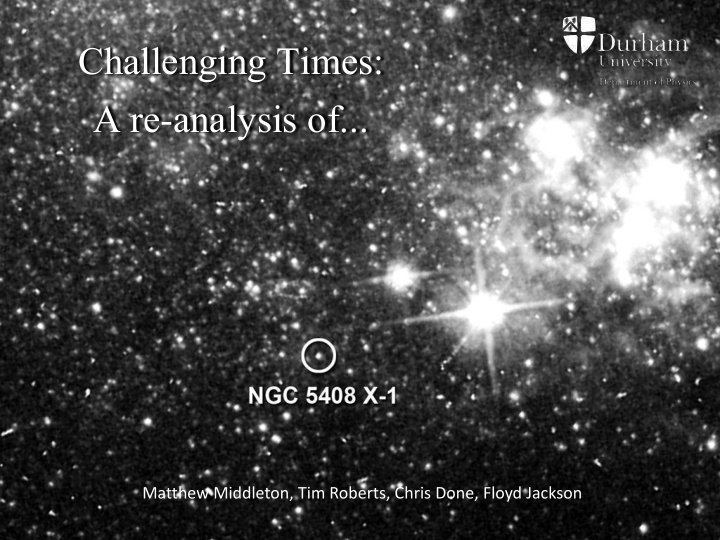



Challenging Times: A re-analysis of... Matthew Middleton, Tim Roberts, Chris Done, Floyd Jackson
What defines a ULX? 1. L > 10 39 erg s -1 2. Distinct from centre of galaxy Also ... 1. Not coincident with background AGN or QSOs 2. Often found in star-forming regions (Gao et al. 2003)
X-ray spectra Spectral analysis compresses timing information but ok for first order analysis. Can fit 2 component model as for other accreting sources... Disk component temperature suggests M ~ 10 3-4 M ʘ
Mass estimate from disc should give sub-Eddington states Inconsistent – we see a break in high signal-to-noise spectra (Gladstone et al. 2009) New model whereby corona is mass-loaded
Warning about spectral fitting, need to use physically motivated models and even then its just a convolution ! Frequency x Energy Frequency x Energy Energy (keV) Energy (keV) Spectral fitting is degenerate: timing analysis can help!
Timing characteristics are species invariant (McHardy et al. 2006). Can use these features (QPOs) to estimate the mass of object. 3 ULXs show QPOs: M82 X-1 X42.3+59 Strohmayer & Mushotzky 2003 Feng, Rao & Kaaret 2010
NGC 5408 X-1 The QPO in NGC 5408 X-1, can indicate the likely mass of the source by determining the likely GBH analogy. Done by Strohmayer & Mushotzky 2009 – type C LFQPO of GBHs.
Problem!! SM09 used 70ks of data from Obs 2 - dominated by bgd flaring. Lets look at the observations again with more appropriate GTIs
Is there a break? F-test >95% significance So there may be a break but data only moderate quality
We still see the QPO in the same E-bands where detection is reported as strongest Is this the type-C LFQPO of GBHs? Can this be tested?
This can be tested: does the position of the QPO obey : Frequency x Power ν b ν h Frequency
What can it be? Lets look at the E-dependent variability on different timescales F var (Vaughan et al. 2003) Can replicate the shape of the variability on all t-scales so two- component model is fine. There is constrained E- dependent rapid variability – fluctuations on short t-scales? Huge fractional variability!!
Level of power is huge: only matched by the most luminous, @Eddington or > Eddington sources... What could it be - wild speculation... If its @Eddington then M~100M ʘ . We can make this from low-Z star see Mapelli et al. 2010 arXiv:1005.3548 .
Attributed to rapid fluctuations (Belloni et al. 2000) ... see Middleton & Ingram in prep. xte.mit.edu/~rr/new_67hz.mov
Summary • Timing characteristics can improve on spectral interpretations which may be degenerate. • Fractional variability suggests that the components vary in different ways as seen in AGN and GBHs. • The position of ν b is determined from simulating the full PDS and indicates that the position of the QPO does not appear to agree with the tight correlation seen in binaries. • If the amount of variability (and X-ray spectrum) is indicative of Eddington/super-Eddington accretion then perhaps the QPO is analogous to the ULFQPO of GRS 1915+105?
Recommend
More recommend